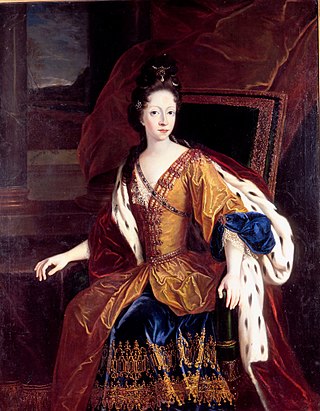
Hans Ulrik Gyldenløve was the illegitimate son of King Christian IV of Denmark and his mistress, Karen Andersdatter. He was also a Danish-Norwegian Navy officer and lensmann bailiff.
Karen Andersdatter was the Danish mistress of King Christian IV of Denmark-Norway and the mother of one of his three illegitimate but acknowledged children, Hans Ulrik Gyldenløve.

Johan Georg Forchhammer was a Danish mineralogist and geologist.

Princess Sophia Hedwig of Denmark and Norway was a Danish princess, the daughter of King Christian V and his queen-consort, Charlotte Amalie of Hesse-Kassel.

The former Diocese of Odense was a Roman Catholic diocese in Denmark which included the islands of Funen, Langeland, Tåsinge, Lolland, Falster, Als, and Ærø. Its episcopal see was located in Odense at St. Canute's Cathedral.

Lady Ingeborg Åkesdotter Tott or 'Ingeborg Aagesdotter of the Thott', in her lifetime called Ingeborg Åkesdotter or simply Fru Ingeborg, was a Swedish noble, the consort of the Swedish regent Sten Sture the elder. She was the fiefholder of Häme in Finland. She functioned as the de facto queen consort of Sweden for over three decades and participated in state affairs during the reign of her spouse.

Ove Rode was a Danish politician, writer, newspaper editor, and Minister of Interior Affairs for Det Radikale Venstre.
Brita Olovsdotter Tott or Birgitte Olufsdatter Thott, was a Danish and Swedish noble, landowner and royal county administrator She was judged for treason and for the forgery of seals. She was one of the biggest landowners in Scandinavia, and her estates played a role in politics in Sweden and Denmark.

Princess Anna Sophie of Denmark and Norway was the eldest daughter of King Frederick III of Denmark and Sophie Amalie of Brunswick-Lüneburg, and Electress of Saxony from 1680 to 1691 as the wife of John George III.

Peder Hansen Resen was a Danish historian, legal scholar and president of Copenhagen.
Edele Jernskjæg was a Danish noble, courtier and the royal mistress of King John I of Denmark.

Anne Meinstrup (1475–1535) was a politically active Danish noblewoman, lady-in-waiting and county administrator.

The Ordre de l'Union Parfaite was created by Queen consort Sophie Magdalene of Denmark and Norway on 7 August 1732 to celebrate the tenth anniversary of her happy marriage with King Christian VI of Denmark and Norway. It was given to both men and women. Its motto was In felicissimæ Unionis Memoriam.

Sophie Lykke was a Danish county administrator, landholder and noble.
Richardis of Schwerin, also called Richardis of Lauenburg or Rixa,, was a Duchess consort of Schleswig and possibly a Danish queen consort, married to Valdemar III of Denmark. She was the daughter of Gunzelin VI, Count of Schwerin-Wittenburg and Richardis of Tecklenburg. She was the aunt of Richardis of Schwerin, Queen of Sweden.
Amalie Münster was a Danish courtier, translator and poet.
Ingeborg Christiane Rosenörn (1784-1859) was a Danish courtier and philanthropist; Overhofmesterinde to the Danish queen, Caroline Amalie of Augustenburg from 1845 to 1859.
Mette Trolle, was a Danish noblewoman, poet and Catholic convert, known for her unconventional life style.

Berte Skeel was a Danish noble, philanthropist and estate owner. She was the owner of Selsø Manor and co-founder of the Roskilde Adelige Jomfrukloster at Roskilde Kloster.

Anna Susanne von der Osten was a Danish courtier and philanthropist.













